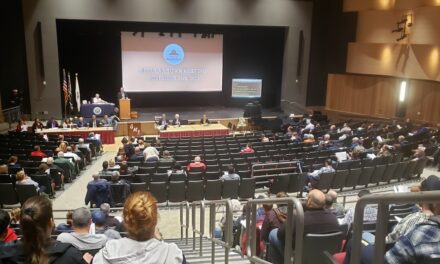By GAIL LOWE
WAKEFIELD — The slide show of photos that fell across the projector screen on the stage of the Galvin Middle School’s auditorium told the story of Ryan Halligan’s formative years but his childhood came to an abrupt end at age 13.
As did his life.
Last night, Ryan’s father — John P. Halligan — spoke to a group of parents, educators, mental health experts and law enforcement officials intent on learning what led to Ryan’s suicide 12 years ago. Earlier in the day, students at the middle school also listened to the story about Ryan.
Real life and online bullying and the accompanying devastating effects were responsible for taking his son’s life, said John Halligan. His mission now is to spread the word far and wide with the hope of putting an end to this latest scourge on society as it applies to our youngest citizens. Halligan does not want to ever hear of another youth taking his or her life due to the effects of bullying, either in person or online.
An engineer at IBM for 23 years, Halligan has since retired and now speaks nearly every day of the school year to groups in the United States, Canada and Mexico. He is also writing a book on the effects of bullying, using Ryan’s story as a guide.
Following a short introduction by Galvin Middle School Principal Mark Bedrosian and comments offered by school psychologists Andrew Cedrone and Jen Hart, Halligan launched into the story of his son.
Born in Poughkeepsie, N.Y. on Dec. 18, 1989, Ryan was an early Christmas gift, said Halligan. By all accounts, his son seemed to be developing normally except for some physical coordination difficulties, but then, at age 2, when Ryan had not said either “Mama” or “Dada,” pediatricians formally diagnosed him with speech/language and motor development delays.
But by age 5, Ryan was speaking normally and had developed an interest in sports — soccer, basketball, baseball and all the rest. Although he overcame his developmental difficulties by grade four, Ryan still struggled and he was placed in Special Education classes at the Hiawatha Elementary School in Essex Junction, Vt. where the family had relocated due to Halligan’s job requirements.
“School was never easy for him but he always showed up with a smile on his face, eager to do his best,” said Halligan.
The bullying started at the Albert D. Lawton Middle School — grade five — just around the age when kids are at their meanest and most inappropriate, Halligan pointed out.
From January to October 2000, Halligan suffered bullying at the hands of a group of students at his school because of his learning disability and because of his physical coordination difficulties.
Ryan’s initial response was to ignore the boys and Halligan supported this approach, suggesting that the ringleader may have been having a difficult time within his family and was taking it out on Ryan. By grade 7, the bullying had stopped.
“There were no tears, no bullying,” said a clearly relieved Halligan.
But in December 2002, Ryan made a chilling statement.
“I hate that school,” he told his parents. He pleaded to be home schooled. He begged for his father to move the family out of the area.
“By age 13, the kid responsible for the bullying was at him again,” said Halligan.
Ryan’s father wanted to take up the problem with the school but Ryan insisted the situation would only worsen and Halligan’s interference would surely embarrass him.
Instead, Ryan asked his father to teach him to fight.
“I need to learn how to defend myself,” he said.
That Christmas, Ryan was given a Taebo Kick Boxing set and he and his Dad developed a routine of practicing in the basement several hours every night.
Soon, Ryan could handle himself but Halligan cautioned him not to pick fights at school. Even so, Ryan had his Dad’s permission to defend himself, if necessary.
A fight with the bully in the winter of 2003 landed both boys in the assistant principal’s office. Following this encounter, the bullying stopped and by the end of grade seven, Ryan told his father that he and the ringleader actually had become friends and he naively trusted the bully even to the point of confiding personal medical information that the bully then used to spread a rumor that Ryan was gay.
Over the summer months, Ryan spent a lot of time online, particularly using instant messaging services, but Ryan kept his activities to himself. Following Ryan’s death, Halligan read these online discussions in multiple folders stored on Ryan’s computer. What he read “broke his heart,” said Halligan.
Ryan had deliberately saved transcripts of online exchanges in which Ashley, a popular girl whom Halligan had a crush on, pretended to like him. But at school, she told him that he was a “loser.”
Ryan’s response to her was, “It’s girls like you who make me want to kill myself.”
And that’s what Ryan did on Oct. 7, 2003. His older sister found his body while Halligan was away on business. He would soon learn about what was happening when Ryan was online.
Following his son’s death, Halligan lobbied for legislation in Vermont to improve how schools address bullying and suicide prevention. He now speaks at schools in various states about the story of his son and the devastating effects of bullying, including cyber-bullying, among teens.
In response to Halligan’s tireless efforts, Vermont enacted a Bullying Prevention Policy Law in May 2004 and later adopted a Suicide Prevention Law (Act 114) in 2005, closely following a draft submitted by Halligan. The law provides measures to assist teachers and others to recognize and respond to depression and suicide risks among teens. Halligan’s case has also been cited by legislators in other states proposing legislation to curb cyber-bullying.
Ryan’s story has been featured on a Frontline television program entitled “Growing Up Online,” produced in January 2008 at a Boston station and distributed nationwide over PBS. In it, Halligan recounts his shock upon discovering the extent of the abuse his son endured, saying he believes that bullying on the Internet “amplified and accelerated the hurt and pain he was trying to deal with, that started in the real world.”
Ryan’s story also has been featured on Oprah in a report the producers did on a rise in homophobic teasing in schools. In addition, he presented his powerful and moving story to many schools across the country.
Forgiveness toward Ryan’s perpetrators did not come easy but it did come.
“My heart broke when I started reading what was in Ryan’s online folders and I wanted to kill the boy who bullied him,” said Halligan.
But he has since softened his view and offered forgiveness to the ringleader and the girl named Ashley.
In hindsight, Halligan said he does not blame the school for what happened to his son, acknowledging that he should have taken up Ryan’s problem with school officials. He also added that he now understands that young brains lack certain abilities such as planning, reasoning, making sound judgments and controlling impulses.
“The frontal lobe of the brain doesn’t fully develop until the mid-20s,” he said.
Halligan is now calling for parents to exercise more control when it comes to technology. He also urges those who witness bullying to be an “up stander” rather than a “bystander.”
“Be concerned about your children’s circle of friends in cyberspace,” he said. “Not just the ones who come to your door. You’ve got to pay attention. Don’t just ask your children ‘how was your day?’ he said. “Ask ‘how do you feel today?’”
Halligan concluded his talk by offering parents suggestions concerning their children’s technology use. He also provided an example of a contract, a must when it comes to children and cell phone use.
For more information about Ryan’s story, visit www.ryansstory.org.




